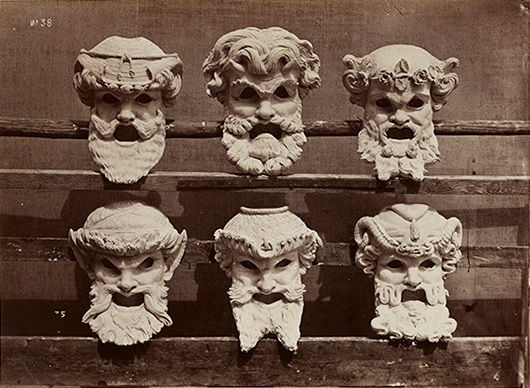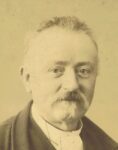
Louis-Émile Durandelle
French, 1839–1917
Masques du vestibule du contrôle (Masks in the security room), 1866-1875 ca.
albumen silver print
10 7/8 x 14 5/8 in.
SBMA, Gift of Jane and Michael G. Wilson
1995.46.2.38

Louis Thiriot - Portrait of Louis Émile Durandelle
COMMENTS
Louis-Émile Durandelle first achieved renown in the mid-1850s, when he co-founded a commercial photography firm with Hyacinthe César Delmaet (1828–1862). Together, Delmaet & Durandelle specialized in engineering and topographical subjects. When Delmaet died suddenly in 1862, Durandelle married his business partner’s widow, Clémence, who kept her first husband’s surname and managed the studio until her death in 1890.
Beginning in 1865, Durandelle collaborated with architect Charles Garnier, systematically documenting the construction of the Paris Opéra (built 1861–75). Commissioned by Napoleon III, the opulent new opera house became the signature landmark of the central grands boulevards district redesigned by Haussmann. On site, Durandelle surveyed the opera house high and low, making hundreds of images of raw building materials, architectural elements, and ornamental sculpture, many of which show skilled masons and sculptors at work. Following this project, Durandelle published more than a hundred large-format photographs of the Paris Opéra, also known as the Palais Garnier after its architect, which he organized into thematic albums such as Ornamental Sculpture (1875). Later, the French government employed Durandelle to photograph such diverse, immense worksites as the Sacré-Cœur Basilica in Montmarte, the Mont-Saint-Michel Abbey in Normandy, and the Eiffel Tower.
https://www.clarkart.edu/microsites/a-city-transformed/about/louis-emile-durandelle
Louis Emile Durandelle was one of the leading photographers of architecture in 19th -century Paris, as a member of the firm Delmaet & Durandelle. He opened a studio with Hycaninthe Cesar Delmaet (1828-1862) around 1854. After Delmaet’s death, Durandelle continued to operate the studio with Delmaet’s widow, Clémence Jacob Delmaet (?-1890), whom he later married.
While the studio made portraits, including cartes de visite, Durandelle’s fame rests on his photography of buildings, particularly the series of photographs of the construction of Charles Garnier’s (1825-1898) Paris Opéra from 1862 through 1875. Durandelle made 200 albumen prints from 38cm x 28 cm glass negatives that captured the detailed decoration of the Opéra as well as the over-all progress of the construction. 115 of his photographs, widely praised for both their clarity and composition, were published in Le Nouvel Opéra de Paris, a set of two volumes of text, two volumes of lithographs and engravings, and four volumes of photographs.
His photographs were exhibited at the 1878 Exposition Universelle in Paris. Durandelle photographed a number of construction projects in Paris and elsewhere in France until 1890, including the reconstruction of the Hôtel-Dieu (1868) and the abbey of Mont-Saint Michel (1874-8), and the construction of the Bibliothèque Nationale (1870), Montmartre’s Sacre Coeur (1877-90), the theater at Monte Carlo (1880) and the Eiffel Tower (1887-9). His photographs of the construction of the Eiffel Tower and Sacre Coeur were published in two-volume albums in 1889 and 1890, respectively.
Like other photographers at the time, Durandelle photographed the destruction wrought by the Franco-Prussian war of 1870-71 and the 1871 Paris Commmune. He won medals at the Expositions Universelle in 1882 and 1889. In 1890, after the death of his wife Clémence, he sold the business to his assistant, Paul-Joseph-Albert Chevojon (1865-1925) and retired to Bois-Colombes, where he married Julie-Eugenie Saint-Léger, and later died in 1917.
https://art.famsf.org/louis-emile-durandelle
SBMA CURATORIAL LABELS
The French photography firm of Delmaet and Durandelle was commissioned to create a visual record of the building of the Palais Garnier in Paris. This grand opera house, begun in 1861 and finished in 1875, was a major part of Napoleon lll’s vast reimagining of the city of Paris. Using the camera as a documentary tool, the photographers captured in a uniquely modern way the intriguing characteristics of masks intended for places that an average visitor would never see. The artists who created these masks were clearly aware of sculptural heads from antiquity, such as those seen in the center of this gallery. However, they added idiosyncratic symbols and expressions that make these fascinating faces a vivid fusion of the ancient and the modern.
- Greco-Roman, 2022
